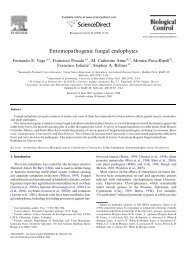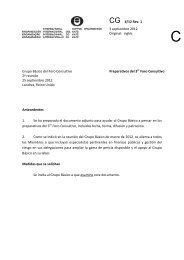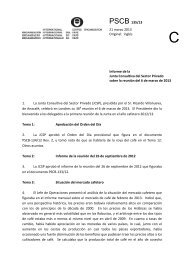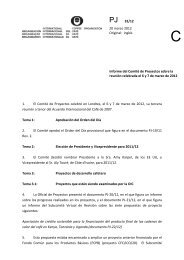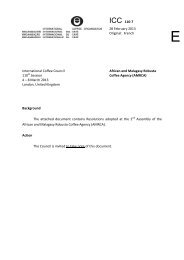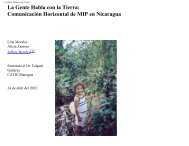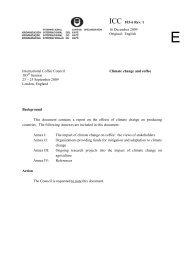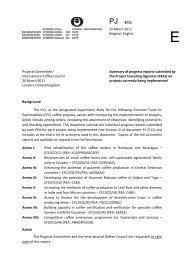Devouring profit - International Coffee Organization
Devouring profit - International Coffee Organization
Devouring profit - International Coffee Organization
You also want an ePaper? Increase the reach of your titles
YUMPU automatically turns print PDFs into web optimized ePapers that Google loves.
Transference of IPM strategies implies a specific approach because IPM is more than a<br />
set of practices to be directly employed, it is a different and unfamiliar way of reasoning<br />
for many farmers. So extensionists must be aware of this key difference in order to<br />
promote and teach IPM effectively (including alternative methods such as participatory<br />
techniques). Perhaps the most difficult concept to transfer is the economic injury level<br />
(EIL).<br />
From the socio-economic characteristics of many coffee growers that we have recorded<br />
in this book, it is difficult to find farmers using IPM tools without considered<br />
advice from the extension services. Unfortunately we found that in almost all the<br />
coffee countries, due to the present economic circumstances, the extension services<br />
have been seriously weakened both in terms of economic resources and number of<br />
active agents. So the service they provide now is quite unsatisfactory because of the<br />
large number of farmers per extension agent. For instance in the Guatemalan case<br />
there are 61,000 coffee farmers attended by 66 extensionists, 925 farmers per technician;<br />
in Ecuador the ratio maybe closer to 2,000 farmers per extensionist. We suggest<br />
that to work with more than about 500 growers per technician is not cost effective.<br />
Thus to improve the adoption of IPM strategies in coffee, more and better informed<br />
extension agents are required if we want to see an improvement in technology uptake.<br />
In future, if extensionists are to be effective, they will have to be better prepared and<br />
better paid to attract people who will effectively become facilitators and knowledge<br />
brokers for a wide range of farmers’ needs. The extent to which they will be able to do<br />
this will depend on the future remit of coffee institutes; will they continue to be<br />
technology driven or will they develop a wider social remit?<br />
Donors: although funds have been donated by national and international bodies to<br />
help solve the problems of coffee communities, their effects have been limited because<br />
of their generally short duration and lack of continuity. Many meetings and<br />
reports on the coffee crisis have been prepared over the last two years and many<br />
interesting ideas have been aired. Little concrete has been achieved however and we<br />
feel that there needs to be concerted action by donors, by working together, to make<br />
their funds count better towards bringing about sustainable change.<br />
7.2 IPM<br />
Labour issues<br />
CBB management for smallholder coffee farmers is based on cultural control and<br />
is reasonably effective, but the current low price climate is incompatible with<br />
high wage costs. Hence as a long-term strategy it may be flawed and if coffee is<br />
to prosper, either labour-saving technologies or high quality premiums will be<br />
required.<br />
Labour may become scarcer in some countries, thus studies are needed to<br />
project labour requirements and relate this to birth, death and migration rates.<br />
75




